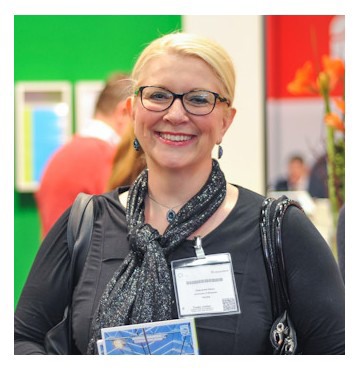 Dr Dubravka Savic is associate professor at the Faculty of Agriculture of the University of Belgrade. She conducts research on controlled environment agriculture and gives lectures on vegetable cultivation and production. As well as this, she gains information on the current trends in advanced horticulture production techniques and how they can contribute to the efficiency of vegetable production in Serbia. According to Prof. Dr Savic, Serbia has great potential for the development of greenhouse horticulture, but there are many hurdles, too.
Dr Dubravka Savic is associate professor at the Faculty of Agriculture of the University of Belgrade. She conducts research on controlled environment agriculture and gives lectures on vegetable cultivation and production. As well as this, she gains information on the current trends in advanced horticulture production techniques and how they can contribute to the efficiency of vegetable production in Serbia. According to Prof. Dr Savic, Serbia has great potential for the development of greenhouse horticulture, but there are many hurdles, too. "Serbia used to have a thriving greenhouse sector during the 1970's and 1980’s; there was a strong industry with efficient glasshouses according to that period, fully equipped with all installations inside. Those greenhouses were part of big systems, successful agricultural corporations that were financed by the government of former Yugoslavia. Composition of those giants was interesting and complex. It was the golden era of the horticultural sector in former Yugoslavia (especially focused on vegetable and flower production). However, after the fall of Yugoslavia, the entire economy collapsed.”
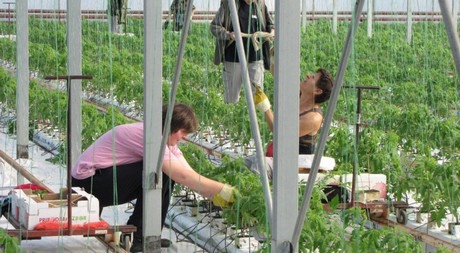
The Serbian growers at Sagal grow hydroponic tomatoes in a plastic greenhouse of 2.8 hectare. They work together with a Dutch consultant. The starter plants come from a company in Hungary.
Agricultural
This situation reflected on agriculture in general, because onetime big governmental and successful corporations and smaller private sector companies faced a new economical framework. “Primarily, it was a new vision of ownerships and a new type of governmental finance support. It was a transition era; it was not easy to ‘jump’ from one economy system to a completely new one. However, it was understood and accepted in Serbia in time. The period of adaptation still continues, and constructive changes are coming up. Over the past few years, Serbian economy is climbing again, but agricultural reform still demands some qualitative changes.”Nowadays, big private holdings set up good positions in the horticultural sector in Serbia, while middle and small farms need bigger support by the government in order to develop and improve their production technology, and get more knowledge, information and skill. Small and middle farms represent the majority of the Serbian horticultural sector and agriculture, in general. It is one of the most important reasons to invest in their road to success.
Savic stresses that the new economical opportunities should be supporting the modernizing, development and intensifying of production of small and middle farms. The Serbian Ministry of Agriculture and Environmental Protection has been doing its best to realize those changes in agricultural strategies, although it moves a bit slowly.
Lack of finances, unfavourable subsidies, inappropriately organized farmers’ cooperatives and still not so efficient agrarian policy in Serbian horticulture sector, have the biggest influence on bringing decisions about choice of investments and type of primary horticultural production by farmers or potential investors. It has the biggest impact on investments in the greenhouse sector.
That is why the greenhouse sector in Serbia consists of:
- Low cost, small tunnel greenhouses for the production of vegetables and soft fruits (especially, strawberries) on soil; this type of greenhouse constitutes the majority of the Serbian greenhouse sector.
- Several bigger plastic greenhouses, with some installations inside and roof ventilation, were built in recent years, and vegetable production is carried out on soil, organic substrates and hydroponics on rock wool.
- Glasshouses are also present. In the recent years, brand new and second-hand glasshouses were built (approximate area per glasshouse is 1-2ha), and one revitalized glasshouse (that comes from the golden era of the 1970’s). In those glasshouses, modern production technology is mainly applied to vegetable cultivation on organic or rock wool substrates, and rarely on soil.
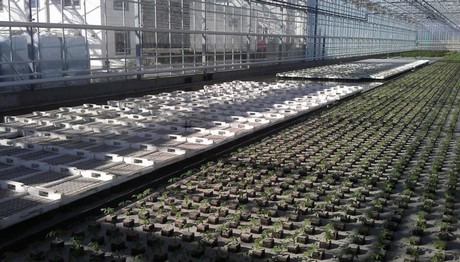
Propagator Grow Rasad is a new glasshouse in Vojvodina, 50 kilometres from Belgrade. The company was founded as a Serbian subsidiary of Dutch young plant propagator Grow Group.
Geothermal energy
In some parts of Serbia, there are excellent opportunities for the whole seasons horticultural production in greenhouses, thanks to geothermal energy with high water temperature up to 78-80 degrees Cesius, good water availability and other good characteristics of those geothermal resources. However, such geothermal wells still are not used for the horticultural production in greenhouses. Actually, it would be possible to invest in high-tech glasshouses with high quality installations inside, for year round vegetable production. With geothermal wells with high water temperature, it would be possible to realize great energy savings for heating. Capacities of those geothermal wells, in several parts of Serbia, allow building and heating approximately 10ha of glasshouse area per geothermal well. 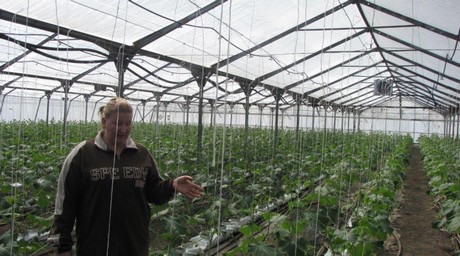
The nursery Lazar Djukic grows coarse tomatoes, cucumbers and bell peppers. They have plastic greenhouses, new and older. Remarkable aspect is the modern pure CO2 dosage system that the grower has installed.
Fruit sector
Regarding the fruit sector, there is a trend of growing various soft fruits, especially strawberries, in simple plastic greenhouses, growing in the soil. However, soft fruits are mainly growing on the open field and there is a tendency of improving varieties, which are virus free and with a longer shelf life in fresh condition. It is very important especially for raspberries, because Serbia is one of the biggest exporters of raspberries but mainly processed (frozen). Serbia has favourable soil and climate for soft fruits which mainly ripen earlier than in the western part of Europe and have an excellent taste. At the same time, there are several bigger orchards, with an approximate area of 100 ha or more. Those orchards (mainly apples) are equipped with modern installations for safe open field production, and getting high quality and quantity of fruits.GLOBAL G.A.P
In addition, general tendency in Serbia is the implementation of the GLOBAL G.A.P. standard in primary horticultural production. Significant issues are development or improved postharvest handling and postharvest technology of vegetables and fruits, and setting up reliable and accredited laboratories for safe and profitable horticultural production. Bigger distributive centres would be a good investment and choice, too. In former Yugoslavia, the processing industry was very well built-up, but nowadays it is not developed, and there is a space for it to be started up and grown. There is a demand for mechanization for vegetable cultivation and harvesting on the open field as well as for automation of some cultivation processes in greenhouses. In fruit production, especially soft fruit production, harvesting machinery is very interesting.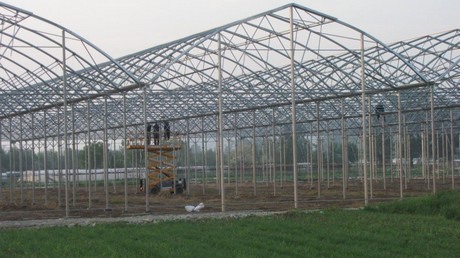
In 2011, Bojan Stankovic built a new plastic Richel house. the grower produces tomatoes, lettuce, cucumbers in the southern part of Serbia.
Plans for expansion, land available
There is intention for expanding irrigation systems on the open field and greenhouse horticultural production, especially the renewing of channels with water for irrigation and applying drip irrigation on the open field and, especially in greenhouses. Approximate rainfall in lowland region is 600 – 800 mm, and in mountain area it is around 800 - 1200mm. However, rainfall is randomly distributed over the vegetation season. Serbia has a total agricultural production area of approximately 5.7 hectares. The arable area is around 4.8 million hectares. The most common branches of agriculture are: animal husbandry (43%), the arable and vegetable crops (42%), then fruit and vineyards (12%), and other plants (3%).
There is a lot of area available to expand the cultivation of fruit and vegetables, in both open field and greenhouses.
Local market
At this moment Serbia has a total of more than 60 hectares of greenhouses; most of them are mainly small plastic tunnel greenhouses with vegetable production on the soil. "There is not too much development of new modern glasshouses at the moment.The production is mainly for local market. Actually, vegetable production is mainly for the local market, and fruit production is both for local and foreign market (surrounding countries and countries of EU). If we would have made well-organized cooperatives, we would be able to export big quantities of vegetables and fruits, oriented for local and foreign markets. Well-organized cooperatives are very important because of the average farm area that is around 3-4 hectares. Certainly, there are some individual farms with an area of a few hundred hectares. Well-organized cooperatives would be able to implement easily many significant issues that are important for producers, environment, consumers, marketing, positioning at local and foreign markets, etc.
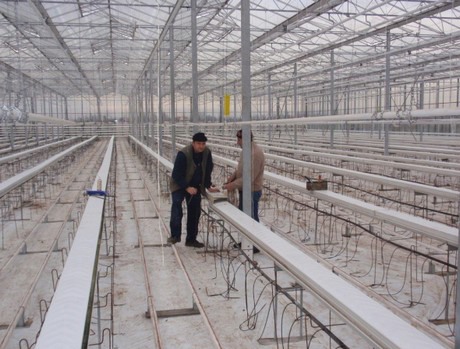
Serbian tomato grower Branko Pesut owns a 2 ha secondhand greenhouse that is equipped with geothermal energy and a screening system.
As well as this Serbia has bigger production for export of soft fruit and apples, Prof. Dr. Savic stressed that the country has got potential to increase the domestic greenhouse production due to the improved situation and export opportunities.
"The demand for locally produced greenhouse vegetables is on the rise, as well as the demand from surrounding countries. There is a free trade agreement between Serbia and Russia, so the growers have the possibility to easily export to a very large and interesting market. As well as this, Serbia is in the process of becoming a member of the EU. This might open up other markets as well."
The climatic conditions of Serbia are suitable for open field and for greenhouse cultivation as well. Another big potential is the availability of geothermal energy. "We have high light levels available and thanks to the geothermal well, greenhouses can be heated against low cost."
According to Prof. Dr. Savic, the only reason why Serbia is currently staying behind in the development of horticulture is an inappropriate agrarian strategy. "The government has stressed it's concerns on agriculture and they are committed to making more subsidies and funding available, but it takes time."
A lot of work to do
Prof. Dr. Savic concluded by mentioning that there is a lot of work to do. "It is a pity, because our country has such potential to establish a very nice greenhouse industry. We should take an example to the current Mexican greenhouse industry expansion; they works closely together with the Dutch industry to develop a very impressive local industry that is now producing high quality greenhouse produce for the North American market."If you would like more information on horticulture in Serbia, please contact Professor Dubravka Savic.
University of Belgrade, Faculty of Agriculture
Dept. of Field and Vegetable Crop Science
Dr. Dubravka Savic -Associate Professor
[email protected]
Skype: Dunya_Savic
www.agrif.bg.ac.rs










